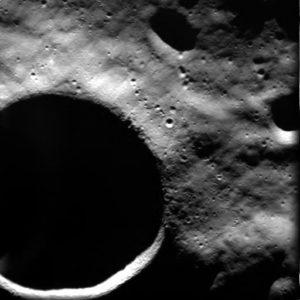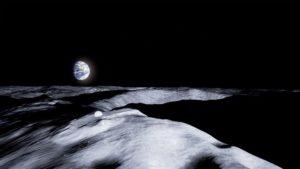
Image of the Shackleton Crater taken by the advanced Moon Imaging Experiment (AMIE) on board ESA’s SMART-1 spacecraft
Near the south pole of the moon, where the sun is low in the sky, one deep crater, stretching 4.2 km down into the lunar soil, is in perpetual darkness. In sharp contrast, the crater’s rim features bright peaks almost constantly lit by the sun. It’s called the Shackleton Crater, and it’s not only a striking feature of the lunar surface, it’s a potentially very useful one, according to the scientists studying the possibilities for future moon settlement.
The European Space Agency (ESA) has been very vocal about its intentions to create a 3D printed base on the moon, and the Shackleton Crater is one location that has been pinpointed as a promising one for a future settlement because of its depth and darkness, which create what’s known as a “cold trap” that may hold reserves of ice – meaning that it could serve as a source of water, oxygen and fuel. Meanwhile, its sunlit peaks provide an ideal location for living and working.
An artist named Jorge Mañes Rubio has ideas that go further than the purely functional buildings the ESA has in mind. Rubio is the ESA’s artist in residence and a member of the Advanced Concepts Team (ACT), a think tank that researches emerging and future science technology and their possible applications for future ESA projects and missions. In his opinion, places to live, work and research aren’t enough for a future long-term settlement.
In this concept image, the tiny gleaming dot on the left rim of the crater represents Rubio’s Moon Temple.
“I’ve been having all sorts of discussions with my ACT colleagues, including speculating on the likely needs of future lunar settlers,” said Rubio. “What kind of social interactions will they share, what cultural activities and rituals will they have, and what sort of art and artefacts will they be producing? Humans have been creating art for at least 30 000 years, so I have no doubt this will continue in space and on the Moon.”
With that in mind, Rubio wants to construct what he calls a “Moon Temple,” a sunlit dome on the peaks of the Shackleton Crater that will serve as a place of contemplation and a symbol of unity.

“Lunar settlement represents a perfect chance for a fresh start, a place where there are no social conventions, no nations and no religion, somewhere where these concepts will need to be rethought from scratch,” he said. “Humans have brought flags to the Moon, but they’ve been bleached white by sunlight since then – almost as if the Moon is protecting itself from such terrestrial concepts. So this Temple is intended as a mythic and universal structure that can hopefully bring people together in this new environment in novel ways.”
Rubio envisions a 50-foot-tall dome with two openings: one looking towards Earth, and another looking upward towards deep space. Around the roof’s opening would be three horizontal cuts that would allow the sunlight to flow in and illuminate the interior, and in the center of the floor, directly beneath the roof opening, would be a liquid mirror telescope. Terraced steps would lead up to the lofty temple. Like the other structures that have been proposed for the potential moon settlement, he sees the dome being created through 3D printing, using lunar soil as a printing material.
While such a structure would eventually collapse under its own weight on Earth, the moon’s one-sixth gravity environment would allow it to stand freely. Both the ESA and NASA have been studying the use of simulated lunar and Martian materials to create 3D printed structures, and Rubio’s next step is to create a series of 3D printed sculptures and artifacts from the same type of simulated lunar soil used at the ESA’s European Astronaut Centre, which houses an artificial lunar environment. Discuss in the Moon Temple forum at 3DPB.com.
